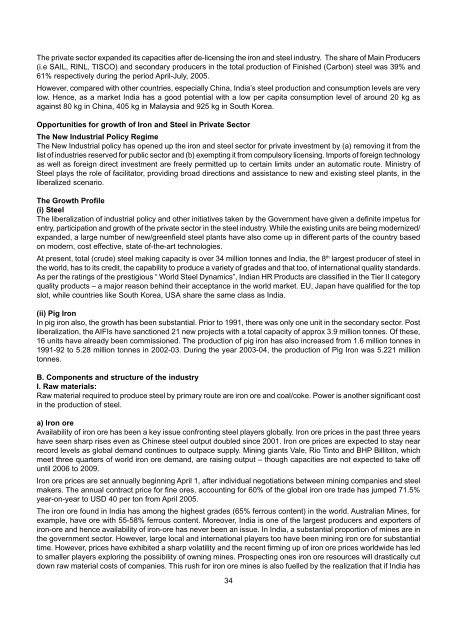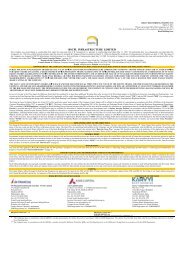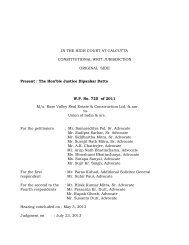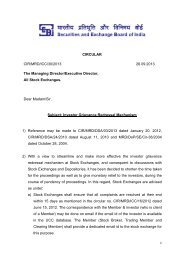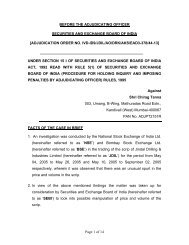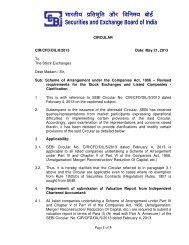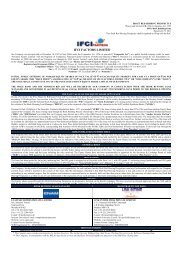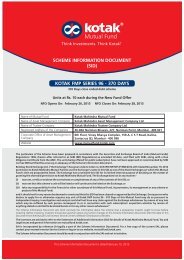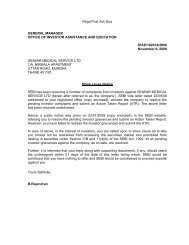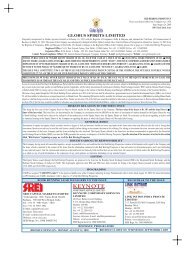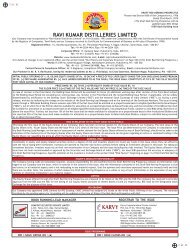KAMDHENU ISPAT LIMITED - Securities and Exchange Board of India
KAMDHENU ISPAT LIMITED - Securities and Exchange Board of India
KAMDHENU ISPAT LIMITED - Securities and Exchange Board of India
Create successful ePaper yourself
Turn your PDF publications into a flip-book with our unique Google optimized e-Paper software.
The private sector exp<strong>and</strong>ed its capacities after de-licensing the iron <strong>and</strong> steel industry. The share <strong>of</strong> Main Producers<br />
(i.e SAIL, RINL, TISCO) <strong>and</strong> secondary producers in the total production <strong>of</strong> Finished (Carbon) steel was 39% <strong>and</strong><br />
61% respectively during the period April-July, 2005.<br />
However, compared with other countries, especially China, <strong>India</strong>’s steel production <strong>and</strong> consumption levels are very<br />
low. Hence, as a market <strong>India</strong> has a good potential with a low per capita consumption level <strong>of</strong> around 20 kg as<br />
against 80 kg in China, 405 kg in Malaysia <strong>and</strong> 925 kg in South Korea.<br />
Opportunities for growth <strong>of</strong> Iron <strong>and</strong> Steel in Private Sector<br />
The New Industrial Policy Regime<br />
The New Industrial policy has opened up the iron <strong>and</strong> steel sector for private investment by (a) removing it from the<br />
list <strong>of</strong> industries reserved for public sector <strong>and</strong> (b) exempting it from compulsory licensing. Imports <strong>of</strong> foreign technology<br />
as well as foreign direct investment are freely permitted up to certain limits under an automatic route. Ministry <strong>of</strong><br />
Steel plays the role <strong>of</strong> facilitator, providing broad directions <strong>and</strong> assistance to new <strong>and</strong> existing steel plants, in the<br />
liberalized scenario.<br />
The Growth Pr<strong>of</strong>ile<br />
(i) Steel<br />
The liberalization <strong>of</strong> industrial policy <strong>and</strong> other initiatives taken by the Government have given a definite impetus for<br />
entry, participation <strong>and</strong> growth <strong>of</strong> the private sector in the steel industry. While the existing units are being modernized/<br />
exp<strong>and</strong>ed, a large number <strong>of</strong> new/greenfield steel plants have also come up in different parts <strong>of</strong> the country based<br />
on modern, cost effective, state <strong>of</strong>-the-art technologies.<br />
At present, total (crude) steel making capacity is over 34 million tonnes <strong>and</strong> <strong>India</strong>, the 8th largest producer <strong>of</strong> steel in<br />
the world, has to its credit, the capability to produce a variety <strong>of</strong> grades <strong>and</strong> that too, <strong>of</strong> international quality st<strong>and</strong>ards.<br />
As per the ratings <strong>of</strong> the prestigious “ World Steel Dynamics”, <strong>India</strong>n HR Products are classified in the Tier II category<br />
quality products – a major reason behind their acceptance in the world market. EU, Japan have qualified for the top<br />
slot, while countries like South Korea, USA share the same class as <strong>India</strong>.<br />
(ii) Pig Iron<br />
In pig iron also, the growth has been substantial. Prior to 1991, there was only one unit in the secondary sector. Post<br />
liberalization, the AIFIs have sanctioned 21 new projects with a total capacity <strong>of</strong> approx 3.9 million tonnes. Of these,<br />
16 units have already been commissioned. The production <strong>of</strong> pig iron has also increased from 1.6 million tonnes in<br />
1991-92 to 5.28 million tonnes in 2002-03. During the year 2003-04, the production <strong>of</strong> Pig Iron was 5.221 million<br />
tonnes.<br />
B. Components <strong>and</strong> structure <strong>of</strong> the industry<br />
I. Raw materials:<br />
Raw material required to produce steel by primary route are iron ore <strong>and</strong> coal/coke. Power is another significant cost<br />
in the production <strong>of</strong> steel.<br />
a) Iron ore<br />
Availability <strong>of</strong> iron ore has been a key issue confronting steel players globally. Iron ore prices in the past three years<br />
have seen sharp rises even as Chinese steel output doubled since 2001. Iron ore prices are expected to stay near<br />
record levels as global dem<strong>and</strong> continues to outpace supply. Mining giants Vale, Rio Tinto <strong>and</strong> BHP Billiton, which<br />
meet three quarters <strong>of</strong> world iron ore dem<strong>and</strong>, are raising output – though capacities are not expected to take <strong>of</strong>f<br />
until 2006 to 2009.<br />
Iron ore prices are set annually beginning April 1, after individual negotiations between mining companies <strong>and</strong> steel<br />
makers. The annual contract price for fine ores, accounting for 60% <strong>of</strong> the global iron ore trade has jumped 71.5%<br />
year-on-year to USD 40 per ton from April 2005.<br />
The iron ore found in <strong>India</strong> has among the highest grades (65% ferrous content) in the world. Australian Mines, for<br />
example, have ore with 55-58% ferrous content. Moreover, <strong>India</strong> is one <strong>of</strong> the largest producers <strong>and</strong> exporters <strong>of</strong><br />
iron-ore <strong>and</strong> hence availability <strong>of</strong> iron-ore has never been an issue. In <strong>India</strong>, a substantial proportion <strong>of</strong> mines are in<br />
the government sector. However, large local <strong>and</strong> international players too have been mining iron ore for substantial<br />
time. However, prices have exhibited a sharp volatility <strong>and</strong> the recent firming up <strong>of</strong> iron ore prices worldwide has led<br />
to smaller players exploring the possibility <strong>of</strong> owning mines. Prospecting ones iron ore resources will drastically cut<br />
down raw material costs <strong>of</strong> companies. This rush for iron ore mines is also fuelled by the realization that if <strong>India</strong> has<br />
34


